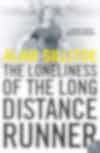The Loneliness of the Long-Distance Runner
By: Jim Burnett
I trotted on along the edge of a field bordered by the sunken lane, smelling green grass and honeysuckle, and I felt as though I came from a long line of whippets trained to run on two legs, only I couldn’t see a toy rabbit in front and there wasn’t a collier’s cosh behind to make me keep up the pace. I passed the Gunthorpe runner whose shimmy was already black with sweat and I could just see the corner of the fenced-up copse in front where the only man I had to pass to win the race was going all out to gain the half-way mark. Then he turned into a tongue of trees and bushes where I couldn’t see him anymore, and I couldn’t see anybody, and I knew what the loneliness of the long-distance runner running across country felt like, realizing that as far as I was concerned this feeling was the only honesty and realness there was in the world and I knowing it would be no different ever, no matter what I felt at odd times, and no matter what anybody else tried to tell me.
Sillitoe, Alan. The Loneliness of the Long-Distance Runner: Stories (Vintage International) (p. 43). Open Road Media. Kindle Edition.
If you just read the excerpt above from The Loneliness of the Long Distance Runner, then I dare you not to read this 48-page short story by Alan Sillitoe (1959) and not see the movie (1962) for that matter.
I can’t remember exactly when it was that I first heard about TLLDR, but I think it was decades ago during the First Running Boom in the late 1970s, and my first thought was – this story must be about how runners are lonely sorts running miles and miles all alone with their own thoughts on backroads and trails far from the madding crowd. Well, this may be correct to a certain extent but that is not all that TLLDR is about by a long shot. As runners we should be grateful that we can continue to ply our craft on the backroads of the Upper Valley despite new social distancing guidelines resulting from the threat of the novel coronavirus. We are fortunate that we can run and ruminate on and on.
It is interesting to me that the author, Alan Sillitoe, is not a runner himself as we may think of a runner today. But really, how could he be a runner as we know it having grown up in post-World War II England (Nottingham), a member of the industrial working class in which running for sport was never a consideration. If Sillitoe had indeed learned how to run as the boy in the story, Smith, had – to escape the grasp of the police, well then, I guess I better understand the source of his insights into what it feels like to fly through the woods and find peace and freedom.






